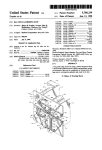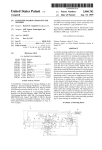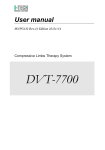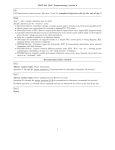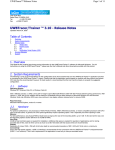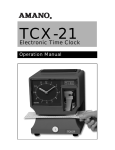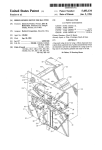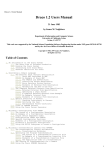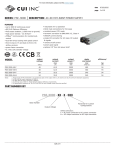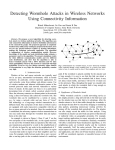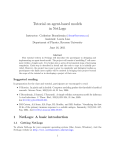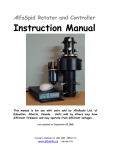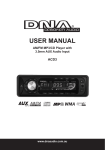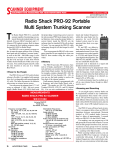Download Capacitor Testing, Safe Discharging and Other Related Information
Transcript
Capacitor Testing, Safe Discharging, and Other Related Information Capacitor Testing, Safe Discharging and Other Related Information Version 2.40 Copyright © 1994-2004 Samuel M. Goldwasser --- All Rights Reserved --For contact info, please see the Sci.Electronics.Repair FAQ Email Links Page. Reproduction of this document in whole or in part is permitted if both of the following conditions are satisfied: 1. This notice is included in its entirety at the beginning. 2. There is no charge except to cover the costs of copying. Capacitor Testing, Safe Discharging, and Other Related Information Table of Contents • Preface Author and Copyright DISCLAIMER Introduction o Scope of Thie Document Safety Considerations o Basic Capacitor Safety o Capacitor Testing Precautions Basic Capacitor Testing o Testing Capacitors with a Multimeter o Ray's Notes on Capacitor Testing o Gary's Comments on Capacitor Testing o What About Capacitance Meters? o More About Capacitor Testing than You Probably Wanted to Know Safe Discharging of Capacitors in TVs, Video Monitors, and Microwave Ovens o Why This Matters o Capacitor Discharge Technique o Capacitor Discharge Tool o Capacitor Discharge Indicator Circuit o Voltage Checkers Equivalent Series Resistance (ESR) and Related Parameters o What is ESR and How Can It be Tested? o More on ESR, DF, and Q o Simple ESR meter schematics and plans o ESR testing without an ESR meter Electrolytics Capacitors and Special Types o Cool Electrolytics - Temperature Rating Versus ESR o Care, Feeding, and Storage of Electrolytic Capacitors o Comments on ESR and uF Ratings o Voltage Rating of Electrolyitc Capacitors Versus Reliability o Some Qs & As about Capacitor Failure o Comments on Old Electrolytics and Failure Mechanisms o What are These Scored Lines on the Ends of Electrolytic Capacitors? o Making Non-Polarized Capacitors from Normal Electrolytics o About Tantalum Capacitors o Supercaps and Ultracaps o What are those X and Y Capacitors in the AC Line Input? o Photoflash Capacitors o o • • • • • • Capacitor Testing, Safe Discharging, and Other Related Information Preface Author and Copyright Author: Samuel M. Goldwasser For contact info, please see the Sci.Electronics.Repair FAQ Email Links Page. Copyright © 1994-2004 All Rights Reserved Reproduction of this document in whole or in part is permitted if both of the following conditions are satisfied: 1.This notice is included in its entirety at the beginning. 2.There is no charge except to cover the costs of copying. DISCLAIMER We will not be responsible for damage to equipment, your ego, blown parts, county wide power outages, spontaneously generated mini (or larger) black holes, planetary disruptions, or personal injury that may result from the use of this material. Capacitor Testing, Safe Discharging, and Other Related Information Introduction Scope of This Document Capacitors may not be considered the superstars of electronic equipment (except perhaps in devices like xenon flash units and pulsed lasers), but more like the helpers and extras. However, they play a vital role in virtually everything that uses electrons in some way. A defective 2 cent capacitor in a TV or monitor can render it useless. This document describes techniques for the testing of capacitors using a multimeter without a capacitance test mode. Information on safe discharging of high value or high voltage capacitors and a discharge circuit with visual indication of charge and polarity is also included. There is also general information on capacitors, capacitance and ESR meters, and other related topics. Capacitor Testing, Safe Discharging, and Other Related Information Safety Considerations Basic Capacitor Safety While accidental contact with capacitors on a 3.3 V logic board isn't going to result in a shocking experience, this is not true of many common types of equipment including TVs, computer and other monitors, microwave ovens; the switchmode power supplies in some VCRs, laptop computers, camcorder battery chargers; electronic flash and other xenon strobes; laser power supplies, and many other consumer and industrial devices. Where equipment is AC line connected or uses high voltages, special precautions are required both for personal safety and to prevent damage to circuitry from careless actions. In addition to the specific safety issues with respect to capacitors discussed below, read, understand, and follow the recommendations provided in the document: Safety Guidelines for High Voltage and/or Line Powered Equipment before attempting any testing or repairs to equipment for which this applies. Capacitor Testing, Safe Discharging, and Other Related Information Capacitor Testing Precautions WARNING: make sure the capacitor is discharged! This is both for your safety and the continued health of your multimeter. A pair of 1N400x diodes in parallel with opposite polarities may help protect the circuitry of a DMM. Since a DMM doesn't supply more than 0.6 V generally on ohms ranges, the diodes will not affect the readings but will conduct should you accidentally put the meter across a charged cap or power supply output. They won't do much with a charged 10 F capacitor or high current supply where you forgot to pull the plug but may save your DMM's LSI chip with more modest goof-ups. This approach cannot be used with a typical analog VOM because they usually supply too much voltage on the ohms ranges. However, my 20 year old analog VOM has something like this across the meter movement itself which has saved it more than once. Capacitor Testing, Safe Discharging, and Other Related Information Basic Capacitor Testing Testing Capacitors with a Multimeter Some DMMs have modes for capacitor testing. These work fairly well to determine approximate uF rating. However, for most applications, they do not test at anywhere near the normal working voltage or test for leakage. However, a VOM or DMM without capacitance ranges can make certain types of tests. For small caps (like 0.01 uf or less), about all you can really test is for shorts or leakage. (However, on an analog multimeter on the high ohms scale you may see a momentary deflection when you touch the probes to the capacitor or reverse them. A DMM may not provide any indication at all.) Any capacitor that measures a few ohms or less is bad. Most should test infinite even on the highest resistance range. For electrolytic caps in the uF range or above, you should be able to see the cap charge when you use a high ohms scale with the proper polarity - the resistance will increase until it goes to (nearly) infinity. If the capacitor is shorted, then it will never charge. If it is open, the resistance will be infinite immediately and won't change. If the polarity of the probes is reversed, it will not charge properly either - determine the polarity of your meter and mark it - they are not all the same. Red is usually **negative** with VOMs, for example. Confirm with a marked diode - a low reading across a good diode (VOM on ohms or DMM on diode test) indicates that the positive lead is on the anode (triangle) and negative lead is on the cathode (bar). If the resistance never goes very high, the capacitor is leaky. The best way to really test a capacitor is to substitute a known good one. A VOM or DMM will not test the cap under normal operating conditions or at its full rated voltage. However, it is a quick way of finding major faults. Capacitor Testing, Safe Discharging, and Other Related Information A simple way of determining the capacitance fairly accurately is to build an oscillator using a 555 timer. Substitute the cap in the circuit and then calculate the C value from the frequency. With a few resistor values, this will work over quite a wide range. Alternatively, using a DC power supply and series resistor, capacitance can be calculated by measuring the rise time to 63% of the power supply voltage from T=RC or C=T/R. Capacitor Testing, Safe Discharging, and Other Related Information Ray's Notes on Capacitor Testing (This section from: Raymond Carlsen ([email protected]) The best technique depends on what the cap is used for. A lot of electrolytics are said to be "leaky" when they are really partially open and just not doing their job. Electrolytics that are actually electrically leaky are not as common. You can take each capacitor out of circuit and test it with a cap checker or even a VOM, but incircuit testing is faster. I don't like to grab for a soldering iron unless I'm pretty sure the part is bad. Time is money. I first do a visual inspection and see if any electrolytics are bulging (they -are- leaky and usually get hot), or physically leaking (corrosion around terminals). Bulging caps in a switching power supply are a dead giveaway, but can point to leaky diodes as well. Next, if the unit will power up, I look for signs of filter caps open... hum bars in picture, hum in audio, flickering displays, low B+ but nothing gets hot, etc. You can tell quite a lot by just being observent and a makling a few simple checks. Try all controls and switches... you may get other clues. What works and what doesn't? If you have an obvious fault... like a reduced vertical scan on a TV set or monitor for example, to find the cap that is starting to open up, you can bridge each of them with another cap, one at a time and see if it corrects the problem. (Experience has taught me that bad electrolytics will not -usually- kill vertical sweep completely.) In a TV set that is several years old or more, there could be more than one cap dried out (open). Check them all. "Popping" filters (as it used to be called) by bridging the original with a like value is not good practice with solid state electronics. The shock to a live circuit is likely to damage other components, or it could shock the circuit into working again... for awhile. Then you get to sit there like a fool and wait for it to act up again... minutes or weeks later. For small electrolytics, I use a trick of bypassing each one with a small 0.1 to 0.47uF capacitor while the set is running. If I see -any- change in the performance, I KNOW the original is not doing its job (greatly reduced in value or open). Of course if you hit the timing caps, it will upset the vertical oscillator a bit... that's normal. For bigger electrolytic caps like the one used to feed the yoke or power supply main filters, the only effective way to check them is by substitution with the same or larger capacitance. Turn the set off, connect the new cap into the circuit and power it up again. As I stated before, leaky caps are actually quite rare... but it does happen. They usually upset a circuit a lot more than open ones. Things tend to get hot quickly if the cap is a filter in a power supply. Shorted tantalums and electrolytic caps in power Capacitor Testing, Safe Discharging, and Other Related Information supplies can literally explode. Obviously, leaky caps must be removed from the circuit to substitute them for test purposes. Most of the other types of small capacitors: Mylar, disc ceramic, etc. are pretty rugged. It is rare indeed to find them bad. It happens just often enough to keep a tech humble. Capacitor Testing, Safe Discharging, and Other Related Information Gary's Comments on Capacitor Testing (From: Gary Collins ([email protected]).) All an ohm-meter tells you is if the cap is shorted or not if it is an electrolytic of fairly large value it can tell you if a cap is open. I am a tech in a large industrial controls company in the factory service center. We consider any electrolytic cap to be suspect if it's code date is over five years old. We have a Fluke 97 and it is useless for in circuit tests. All a meter like a Fluke 97 can tell you is if the Cap is on the way to being open from electrolyte loss or if it is shorted. Actually not all you need to know. Several other facts you need to know are what is the conductance (internal leakage resistance), it sometimes varies with voltage. You also need to know what a caps power factor is in some cases. That is its ability to pass A.C. This is especially important in computer equipment that has to pass harmonics and noise to ground. Switching power supplies like are found in almost all PC's these days use high frequency voltage converters to regulate voltage. The harmonics and noise produced by this rapid switching heats DC filter caps and causes them to loose moisture from their imperfect seals. This effect causes the capacitor to gradually open or drop in capacitive value. If you are talking about other types of capacitors you can test their value with a meter but I have seen caps that look good with a meter but break down under voltage. Special cap meters exist that test all these parameters and let you judge whether the cap is good or not but the best test short of that is to replace the cap and see if it works or not. Feel free to ask if that isn't what you wanted to know. Actually sometimes the best test is to use a oscilloscope to look at what the cap is doing in the circuit. What About Capacitance Meters? Simple capacitance scales on DMMs just measure the capacitance in uF and do not test for leakage, ESR (Equivalent Series Resistance), or breakdown voltage. If the measurement comes up within a reasonable percentage of the marked value (some capacitors have tolerances that may be as much as +100%/-20% or more), then in many cases, this is all you need to know. However, leakage and ESR frequently change on electrolytics as they age and dry out. Many capacitance meters don't test anything else but are probably more accurate than a cheap DMM for this purpose. A meter of this type will not guarantee that your capacitor meets all specifications but if it tests bad - very low - the capacitor is bad. Capacitor Testing, Safe Discharging, and Other Related Information This assumes that the test was made with the capacitor removed (at least one lead from the circuit - otherwise other components in parallel can affect the readings. To more completely characterize a capacitor, you need to test capacitance, leakage, ESR, and breakdown voltage. Other parameters like inductance aren't likely to change on you. ESR testers, which are for good for quick troubleshooting, are designed to just measure the Equivalent Series Resistance since this is an excellent indicator of the health of an electrolytic capacitor. Some provide only a go/no go indication, which other actually display a reading (usually between 0.01 and 100 ohms so they can also be used as low-ohms meters for resistors in non-inductive circuits). Note: always place the test probes on the capacitor terminals themselves if possible. Any wiring between your meter and the capacitor may affect the readings. Although your user manual may state that you can test capacitors in-circuit, other components in parallel with the capacitor can screw up the readings - usually resulting in an indication of a shorted capacitor or excessively large uF value. Removal is best. Unsoldering only one of the pins is adequate if you can isolate it from the circuit. Substitution is really the best approach for repair unless you have a very sophisticated capacitance meterd. The March 1998 issue of Popular Electronics has plans for a digital capacitance tester with a range from 1 pF to 99 uF. The May 1999 issue of Popular Electronics has plans for an "Electrolytic Meter" which will accurately measure the capacitance and allow the determination of some of the other characteristic of large value capacitors - up to several hundred thousand uF. This is basically a time constant based tester using a constant current source. Capacitor Testing, Safe Discharging, and Other Related Information More About Capacitor Testing than You Probably Wanted to Know (From: John Whitmore ([email protected]).) First, you need an AC ripple current source. Then, you tune to the frequency of interest (120 Hz for rectifier power supply filter capacitors is usual) and apply both the AC current and a DC voltage bias. Measure the phase shift between the current and the voltage (for a perfect capacitor, this is 90 degrees) and measure the induced voltage (for a perfect capacitor, this is I*2*pi*f*C). Take the tangent of the difference of the phase shift and 90 degrees. (This is 'tan(delta)' and appears on the spec sheet for the capacitor...) Then remove the AC, and crank the DC bias up to the voltage surge rating; measure leakage current. Ramp the DC bias down to the working voltage rating; measure leakage current. Raise temperature and repeat the capacitance, phase shift, and working-voltage measurements at the max temperature the capacitor is rated for. Yes, it DOES sound rather elaborate, but that's the test that the manufacturers use. Capacitor Testing, Safe Discharging, and Other Related Information Safe Discharging of Capacitors in TVs, Video Monitors, and Microwave Ovens Why This Matters It is essential - for your safety and to prevent damage to the device under test as well as your test equipment - that large or high voltage capacitors be fully discharged before measurements are made, soldering is attempted, or the circuitry is touched in any way. Some of the large filter capacitors commonly found in line operated equipment store a potentially lethal charge. This doesn't mean that every one of the 250 capacitors in your TV needs to be discharged every time you power off and want to make a measurement. However, the large main filter capacitors and other capacitors in the power supplies should be checked and discharged if any significant voltage is found before touching anything some capacitors (like the high voltage of the CRT in a TV or video monitor) will retain a dangerous or at least painful charge for days or longer! A working TV or monitor may discharge its caps fairly completely when it is shut off as there is a significant load on both the low and high voltage power supplies. However, a TV or monitor that appears dead may hold a charge on both the LV and HV supplies for quite a while - hours in the case of the LV, days or more in the case of the HV as there may be no load on these supplies. The main filter capacitors in the low voltage power supply should have bleeder resistors to drain their charge relatively quickly - but resistors can fail. Don't depend on them. There is no discharge path for the high voltage stored on the capacitance of the CRT other than the CRT beam current and reverse leakage through the high voltage rectifiers - which is quite small. In the case of old TV sets using vacuum tube HV rectifiers, the leakage was essentially zero. They would hold their charge almost indefinitely. Capacitor Testing, Safe Discharging, and Other Related Information (From: Edwin Winet ([email protected]).) Some of us work in areas where capacitors are huge, unusual or sometimes both. Many people believe that only "big" capacitors can kill you, knock you across the room, blow a hole in you, or get your attention. Here are a couple of comments: When a capacitor is safely discharged, do not stop there. Some capacitors, due to their ability to leak---are "dead" after being safely discharged with a "bleeder resistor" of the right value for the job. Using a resistor that is under-rated - wattagewise - can result in the bleeder going open circuit DURING a discharge sequence LEAVING some energy! High voltage capacitors, or worse yet, high energy-high voltage capacitors require correct wattage AND correct resistance to be bled safely. Also, high microfarad low voltage capacitors can vaporize a screwdriver and spray metal in your eyes. (Adequate voltage margin is also essential for resistors used in high voltage circuits. --- Sam.) Certain types of capacitors are made of VERY good materials, which can hold a charge for YEARS! Putting away charged capacitors of this type is an invitation to disaster! Low inductance capacitors that are used in energy pulse circuitry, many times are of the oil-filled high energy/high voltage type. This type can give a MOST un-pleasant surprise AFTER it has been completely drained by a safe bleeding technique. After the capacitor has been bled, IMMEDIATELY short it, from terminal to terminal AND to the external metal can (if applicable)!!! These capacitors RE-charge from their internal fluid and can STILL deliver a lethal, as they "recover" a certain amount of energy! this type of capacitor, or any capacitor of any high (enough) energy value MUST be LEFT shorted. Be particularly leery of any capacitor with a broken off lead that is sitting in a drawer! Sometimes, these units break off during testing and don't get thrown out but remain charged - to kill or shock years later. Lastly, the word "electrocution" is used in many high voltage device writings. That's bad, because it was only intended for the "electric chair", short for electro + execution. Capacitor Testing, Safe Discharging, and Other Related Information Capacitor Discharge Technique The technique I recommend is to use a high wattage resistor of about 5 to 50 ohms/V of the working voltage of the capacitor. This isn't critical - a bit more or less will be fine but will affect the time it takes to fully discharge the capacitor. The use of a current limiting resistor will prevent the arc-welding associated with screwdriver discharge but will have a short enough time constant so that the capacitor will drop to a low voltage in at most a few seconds (dependent of course on the RC time constant and its original voltage). Then check with a voltmeter to be double sure. Better yet, monitor while discharging (monitoring is not needed for the CRT - discharge is nearly instantaneous even with multi-M ohm resistor). Obviously, make sure that you are well insulated! • • • For the main capacitors in a switching power supply, TV, or monitor, which might be 400 uF at 350 V, a 2 K ohm 25 W resistor would be suitable. RC=.8 second. 5RC=4 seconds. A lower wattage resistor (compared to that calculated from V^^2 / R) can be used since the total energy stored in the capacitor is not that great. For the CRT, use a high wattage (not for power but to hold off the high voltage which could jump across a tiny 1/4 watt job) resistor of a 1 to 10 M ohms discharged to the chassis ground connected to the outside of the CRT - NOT SIGNAL GROUND ON THE MAIN BOARD as you may damage sensitive circuitry. The time constant is very short - a ms or so. However, repeat a few times to be sure. (Using a shorting clip lead may not be a bad idea as well while working on the equipment - there have been too many stories of painful experiences from charge developing for whatever reasons ready to bite when the HV lead is reconnected.) Note that if you are touching the little board on the neck of the CRT, you may want to discharge the HV even if you are not disconnecting the fat red wire - the focus and screen (G2) voltages on that board are derived from the CRT HV. For the high voltage capacitor in a microwave oven, use a 100 K ohm 25 W (or larger resistor with a clip lead to the metal chassis. The reason to use a large (high wattage) resistor is again not so much power dissipation as voltage holdoff. You don't want the HV zapping across the terminals of the resistor. Clip the ground wire to an unpainted spot on the chassis. Use the discharge probe on each side of the capacitor in turn for a second or two. Since the time constant RC is about 0.1 second, this should drain the charge quickly and safely. Capacitor Testing, Safe Discharging, and Other Related Information Then, confirm with a WELL INSULATED screwdriver across the capacitor terminals. If there is a big spark, you will know that somehow, your original attempt was less than entirely successful. At least there will be no danger. DO NOT use a DMM for this unless you have a proper high voltage probe. If your discharging did not work, you may blow everything - including yourself. The discharge tool and circuit described in the next two sections can be used to provide a visual indication of polarity and charge for TV, monitor, SMPS, power supply filter capacitors and small electronic flash energy storage capacitors, and microwave oven high voltage capacitors. Reasons to use a resistor and not a screwdriver to discharge capacitors: 1. It will not destroy screwdrivers and capacitor terminals. 2. It will not damage the capacitor (due to the current pulse). 3. It will reduce your spouse's stress level in not having to hear those scary snaps and crackles. Capacitor Testing, Safe Discharging, and Other Related Information Capacitor Discharge Tool A suitable discharge tool for each of these applications can be made as quite easily. The capacitor discharge indicator circuit described below can be built into this tool to provide a visual display of polarity and charge (not really needed for CRTs as the discharge time constant is virtually instantaneous even with a muli-M ohm resistor). • • • Solder one end of the appropriate size resistor (for your application) along with the indicator circuit (if desired) to a well insulated clip lead about 2-3 feet long. For safety reasons, these connections must be properly soldered - not just wrapped. Solder the other end of the resistor (and discharge circuit) to a well insulated contact point such as a 2 inch length of bare #14 copper wire mounted on the end of a 2 foot piece of PVC or Plexiglas rod which will act as an extension handle. Secure everything to the insulating rod with some plastic electrical tape. This discharge tool will keep you safely clear of the danger area. Again, always double check with a reliable voltmeter or by shorting with an insulated screwdriver! Capacitor Discharge Indicator Circuit Here is a suggested circuit which will discharge the high value main filter capacitors in TVs, video monitors, switchmode power supplies, microwave oven capacitors, and other similar devices quickly and safely. This circuit can be built into the discharge tool described above (Note: different value resistors are needed for LV, HV, and EHV applications.) A visual indication of charge and polarity is provided from maximum input down to a few volts. Capacitor Testing, Safe Discharging, and Other Related Information The total discharge time is approximately: • • • LV (TV and monitor power supplies, SMPSs, electronic flash units) - up to 1000 uF, 400 V. Discharge time of 1 second per 100 uF of capacitance (5RC with R = 2 K ohms). HV (microwave oven HV capacitors) - up to 5,000 V, 2 uF. Discharge time of 0.5 second per 1 uF of capacitance (5RC with R = 100 K ohms) EHV (CRT second anodes) - up to 50,000 V, 2 nF. Discharge time of 0.01 second per 1 nF of capacitance (5RC with R = 1 M ohm). Note: discharge time is so short that flash of LED may not be noticed. Adjust the component values for your particular application. (Probe) <-------+ In 1 | / \ 2 K 25 W (LV) Unmarked diodes are 1N400X (where X is 1-7) / 100 K 25 W (HV) or other general purpose silicon rectifiers. \ 1 M 10 W (EHV) Resistors must be rated for maximum expected | voltage. +-------+--------+ __|__ __|__ | _\_/_ _/_\_ / | | \ 100 ohms __|__ __|__ / _\_/_ _/_\_ | | | +----------+ __|__ __|__ __|__ __|__ Any general purpose LED type _\_/_ _/_\_ _\_/_ LED _/_\_ LED without an internal resistor. | | | + | Use different colors to indicate __|__ __|__ +----------+ polarity if desired. _\_/_ _/_\_ | In 2 | | | >-------+-------+--------+ (GND Clip) Capacitor Testing, Safe Discharging, and Other Related Information The two sets of 4 diodes will maintain a nearly constant voltage drop of about 2.8-3 V across the LED+resistor as long as the input is greater than around 20 V. Note: this means that the brightness of the LED is NOT an indication of the value of the voltage on the capacitor until it drops below about 20 volts. The brightness will then decrease until it cuts off totally at around 3 volts. WARNING: Always confirm discharge with a voltmeter before touching any high voltage capacitors! For the specific case of the main filter caps of switchmode power supplies, TVs, and monitors, the following is quick and effective. (From: Paul Grohe ([email protected]).) I've found that a 4 watt 'night light' bulb is better than a simple resistor as it gives an immediate visual indication of remaining charge - well down to below 10 V. Once it stops glowing, the voltage is down to non-deadly levels. Then leave it connected for a little while longer, and finish it off with the `ole screwdriver. They're cheap and readily available. You can make dozen 'test-lamps' out of an old 'C7' string of Christmas lights (`tis the season!). Editor's note: where a voltage doubler (or 220 VAC input) is involved, use two such bulbs in series. (From: Dave Talcott ([email protected]).) I built the capacitor discharge tool. I had all the parts to hand except for the series resistor, for which I used a 2 watt axial unit, since the power dissipation is not critical. I decided to package it in probe form for convenience. Except for the series resistor, which lives in a counterbore, everything is surface mounted and communicates through a LOT of cross-drilled holes. A piece of heat-shrink tubing holds everything in place. The only tricky part was making two small recesses to locate the LEDs. The probe tip is a short piece of solid copper wire salvaged from some Romex house wiring and ground to a point. Capacitor Testing, Safe Discharging, and Other Related Information Voltage Checkers Whereas a multimeter is intended to measure voltages (and other things), a checker is used mostly to just produce a quick indication of the presense of voltage, its polarity, and other basic parameters. One use is a quick, but reliable indication of the status of the charge on a BIG capacitor. An, example of a simple version of such a device is the "capacitor discharge indicator circuit" described above. (From: Ian Field ([email protected]).) The version of the checker that I have, also contains a miniature 12 V battery for continuity checking - any resistance less than about 22K will produce some glow. It's handy for quick checks of semiconductor junctions - in general if it produces a slight glow it's leaky, but transistor B/E junctions have an inherent zener voltage, so there is usually some glow. Also schottky-barrier diodes give a reverse leakage glow - this does not mean they're faulty, check the Vf with the diode-check on a DMM before binning! Any zener diode above 10-11 V can be given a quick test for S/C, lower Vz will produce some glow - again check Vf before binning. These checkers are getting hard to obtain, most of the component stockists here only carry vastly over complicated (and expensive) versions with built-in measurement computer and LCD - these wouldn't last 5 min's around flyback circuitry! Some Automotive accessory shops have a simpler version with no battery - always check that it's stated to be capable of measuring AC or DC at 4 to 380 V before parting with money! The internal circuit should contain the LED's, a 15 ohm resistor to limit the maximum surge current when the PTC is cold and the special PTC film-thermistor. The battery can be added with a button from a VCR front panel - but don't blame me if you kill yourself because you didn't insulate the added components properly! There is a more complicated non-battery version with 2 LED's close to the front of the handle to indicate polarity and a row of LED's along the length of the handle to indicate the voltage-range. This version contains 2 special PTC's and a discretetransistor bargraph circuit - there might be room to add a battery inside the case. As for the special PTC this is the only place I've seen them - one possibility that might be worthy of looking into is the Siemens PTC SMPSU startup thermistor for TDA4600 control chips, this usually has a series resistor of at least 270 ohms and is more likely to turn-up in European TV set's, but I have seen it in early Matsushita IBM displays and a few others (possibly Tandon) the PTC thermistor is always blue and looks like a very-miniature copy of the Philips white-plastic PTC degauss thermistor. Capacitor Testing, Safe Discharging, and Other Related Information Capacitor Testing, Safe Discharging, and Other Related Information Equivalent Series Resistance (ESR) and Related Parameters What is ESR and How Can It be Tested? ESR (Equivalent Series Resistance) is an important parameter of any capacitor. It represents the effective resistance resulting from the combination of wiring, internal connections, plates, and electrolyte (in an electrolytic capacitor). The ESR affects the performance of tuned circuits (high ESR reduces the Q factor) and may result in totally incorrect or unstable operation of devices like switchmode power supplies and deflection circuits in TVs and monitors. As would be expected, electrolytic capacitors tend to have a high ESR compared to other types - even when new. However, due to the electrochemical nature of an electrolytic capacitor, the ESR may indeed change and not for the better - with time. Here is a Web site that discusses ESR testing in some detail: • Stephen M. Powell's ESR Page When troubleshooting electronic equipment, electrolytic capacitors, in particular, may degrade resulting in a significant and unacceptable increase in ESR without a similar reduction in uF capacity when measured on a typical DMM's capacitance scale or even a cheap LCR meter. There commercial ESR meters and kits available ranging from $50 to $200 or more. Here are a couple of sites to check out: • • Bob Parker's ESR Meter Site (both low cost kit and assembled versions are available). Capacitor Wizard Site There devices can generally be used to measure really low resistances of noninductive devices or circuits as well (they use AC so inductance would result in inaccurate readings). Since their lowest range is at least 10 times better than a typical DMM (1 ohm full scale - 0.01 ohm resolution), they can even be used to located shorted components on on printed circuit boards. Note: always place the test probes on the capacitor terminals themselves if possible. Any wiring between your meter and the capacitor may affect the readings. While usually not a problem, very low resistance components in parallel with the capacitor may result in a false negative indication - a capacitor that tests good when in fact its ESR is excessive. Capacitor Testing, Safe Discharging, and Other Related Information (From: Larry Sabo ([email protected]).) I find my ESR meter invaluable for finding high ESR caps, and have never seen a shorted cap that hadn't exploded. It's such a pleasure to zip through the caps in a power supply that's duff and find the ones that have had it, all without touching the soldering iron. There have been days I wish I had the LC102 for it's leakage measuring capability, but in my limited experience the 10% figure seems high. The LC102 commends itself for the inductance ringer, too, but you sure pay a premium. I'll build Sam's gizmo first. BTW, I built my ESR meter from a kit purchased from Dick Smith Electronics in Australia, for $A 52.74 + $A 25.00 for delivery. It took about 8 hours to assemble, but I'm a fuss-ass. More on ESR, DF, and Q (From: Michael Caplan ([email protected]).) Before I bought my ESR meter I too wondered--what exactly did it measure? Nevertheless, having heard so much about the meter, I went ahead and bought one. It works, and that's the real bottom line. A recent question about what exactly in being measured (DF or Q) piqued my interest again. I think I have the answer -- 'think' being the operative word. Here's my interpretation. In summary, the ESR is indeed related to Dissipation Factor (DF), but it is not the same. A DF measuring device might not as readily identify a bad capacitor as does the ESR meter because the reading varies and is not direct, as described below. Capacitors may be thought of as having pure capacitance (C) and some pure resistance (R), the two being in series. An ideal capacitor would have only C, and no R. However, there are the leads and plates that have some resistance and constitute real R. Any R in series with C will reduce the capacitor's ability to pass current in response to a varying applied voltage, as in filtering or DC isolation applications, and it will dissipate heat which is wasteful and could lead to failure of the component. As with ESR, a lower DF (or higher Q, it's inverse) may be equated with better performance, all other things being equal. Capacitor Testing, Safe Discharging, and Other Related Information Now I get a bit more mathematical, but only using basic electronic theory and formulas so I hope most will be able to follow this. DF is defined as Rc/Xc, the ratio of the R in the capacitor (Rc) to the reactance of the capacitor (Xc). The higher the Rc, the higher the DF and the "poorer" the capacitor. So far so good. The reactance (Xc) is a function of frequency. Xc=1/(2*pi*f*C). So, as the frequency goes up, Xc goes down. Now look back at the formula for DF. DF is an inverse function of Xc. As Xc goes down, DF goes up, and vice-versa. So DF varies proportionately with frequency. Here's an example using the ubiquitous 22 uF, 16 V electrolytic that seems to be at fault too often in many switched mode power supplies. At 1000 Hz, this capacitor has an Xc of 7.2 ohms. If the series Rc is only 0.05 ohms (pretty good), then the DF is 0.0069. At 50,000 Hz, this same capacitor would have an Xc of only 0.14 ohms. At this frequency, the DF is 0.36, again good. Now, change the Rc from 0.05 to 25 ohms. At 1000 Hz, DF = 3.4. At 50,000 Hz, DF = 178. So we see that DF is a function of the test frequency. The higher the frequency, the higher the DF. DF is a measure of the capacitor "quality", but the figure is valid only at the frequency of the test. (A good capacitor, with an ideal Rc of zero, will have a DF of zero regardless of frequency.) DF can indeed be used to identify a bad capacitor, but the user must interpret the level of measured DF that would indicate a bad component. Any 'go/no go' tables of DF values would be valid only at the specified frequency. As an alternative, the user can calculate the Rc by first measuring both DF and C, and then, knowing the test frequency, determine if the Rc is excessive. (Rc=DP*Xc). The ESR meter measurement system, however, does not appear to be a function of Xc. It measures the voltage across the capacitor resulting from the application of a very short pulse of current. This short pulse is not enough to charge the capacitor so the voltage being measured across the capacitor's leads is primarily a function of Rx, which is not frequency sensitive. And, with the 'tables' of typical ESR (=Rc) that is provided with the ESR meters I have seen, there is no need to do any further calculations. Capacitor Testing, Safe Discharging, and Other Related Information The ESR meter is not going to be reliable with very small capacitors. In this case, they will become more fully charged by the applied current at the time the meter samples the voltage. Even if the Rc is an ideal zero ohms, the meter will now read the voltage built up on the capacitor and interpret it as a very high (possibly off-scale) ESR. Thus its advantage, and main purpose, is in testing electrolytics which tend to be larger value capacitors. (Note: The inability of the ESR meter to test low value capacitors is true only if the meter does not distinguish between in-phase and quadrature voltages, and it does not. If it did sense only the in-phase voltage that is produced across Rx (i.e. in-phase with the applied current), then it would not be sensitive at all to the delayed (minus 90 degrees) voltage built up on the capacitor's plates.) All testing I have done with small capacitors (less than 0.001 uF) seems to suggest that the (Bob Parker) ESR meter is not phase discriminating and Bob Parker has confirmed this. This is not a great disadvantage. The objective of the ESR meter is to identify capacitors that have gone bad. This is more the case with electrolytics where the dielectric compound tends to dry up. Smaller capacitors usually are not electrolytic and therefore tend to be relatively stable. Faults in the latter (e.g. ceramic, mica, polystyrene) are more likely to be open, shorted, or leaky, all of which will be detectable by capacitance or resistance measuring devices.) (From: Roy McCammon ([email protected]).) Note that "equivalent series resistance" is not necessarily the same as "series resistance". "Series resistance" is just the resistance in series with the capacitance. This is what most of the descriptions have delt with, and with high currents and frequencies as you tend to see in a switchmode supply, the "true series resistance" is just what you want to know. "Equivalent series resistance" is the resistance that you would have to place in series with a pure capacitance to produce the same loss. It may be frequency dependent. A cap with a resister in parallel has an esr. At a single frequency, you cannot tell the difference between a cap with a parallel resister and a cap with a series resister. For example, at 100 Hz, a 1 uF and 10 ohm in series has a reactance of 10 + J1591, as does a 1 uf in parallel with 253K, hence both have an ESR of 10 ohms. You need to know just what your meter is doing. It’s best that the measurement relate to your use. Capacitor Testing, Safe Discharging, and Other Related Information Simple ESR meter schematics and plans Electronics magazines have published various ESR meter schematics over the years. Here is one that is unique is being able to test caps on live equipment though I'm not sure what great advantage this is: (From: Pete Culf ([email protected]).) "The January 2003 issue of Television magazine has an article about a live - in circuit electrolytic ESR tester. The battery operated project by Ian field is based on a TL431 high gain comparator with the input isolated via an optocoupler. It is designed for live testing. I haven't built the thing yet as it's my habit to wait awhile and read about any problems the other guys find before I try it, but in subsequent issues I havn't read of any problems." Here are a couple of basic analog ESR meter schematics: Mark Zenier ([email protected]) has an ESR Meter Schematic which is about as simple as it gets. (From: Gary Woods ([email protected]).) Thanks to a friend with a scanner, ESR meter schematics, theory of operation, and sales literature (From a company that, alas, no longer exists) are on my ESR Meter Page. Boat-anchor relevance - although the device is sand-state, it's just the ticket for checking out those old 'lytics! Capacitor Testing, Safe Discharging, and Other Related Information ESR testing without an ESR meter While, the techniques described below can in principle be applied to any capacitor, they will be most useful for electrolytic types. Of course, make sure to observe the polarity and voltage rating of the capacitor during testing! In addition, take care with the maximum voltage applied to other components if you attempt to test caps incircuit. It should be small enough that semiconductor junctions do not get forward biased (a few tenths of a volt max) and the impedance should be such that low value resistors don't smoke! The ultimate in cheap if you have an oscilloscope would be: 99 Cent ESR Test Adapter. (From: Ron Black ([email protected]).) An inexpensive way (for the cost of a resistor) to measure the ESR of a capacitor is to apply a squarewave signal through a resistor in series with the capacitor under test. Monitor the waveform on the capacitor using an oscilloscope. When using a sensible squarewave frequency (a few kHz - not one where the inductance of the circuit becomes an issue) there will be a triangle waveform with a step at the squarewave transition times. The amplitude of the step will proportional to the ESR of the capacitor. Calibrate things by adding a known small value ESR simulating resistor in series with the capacitor. This doesn't have to cost anything if you have a squarewave generator, or can build one cheaply. (From: Gary C. Henrickson ([email protected]).) Motivated by the discussions on the virtues of ESR testing, I ordered a genuine ESR meter. While waiting for it's arrival, a large pile of dogs were accumulating in my shop. To crank out these repairs quickly in the meantime, I constructed an 'ESR meter' by cabling a (50 ohm) function generator output to the scope input and, via a Tconnector, on to a set of test leads. With the test leads shorted, mere millivolts displayed on the scope. Across a good capacitor, mere millivolts. Across a sick capacitor, mucho volts. The defective caps stuck out like a sore thumb. Wow, this is too easy. Instant in-circuit (power off) fool-proof testing of electrolytics. I wish I had thought of this 50 years ago. Capacitor Testing, Safe Discharging, and Other Related Information I used 100 kHz and 5 V p-p. With scope set at 0.2 V/div you can also check diodes surrounded by low ohm transformer or inductor windings. (Editor's note: to avoid the possibility of damage to semiconductors due to excessive voltage, use a lower amplitude signal - say 0.5 V p-p - for in-circuit testing. This will also prevent the most semiconductor junctions from conducting and confusing your readings. (From: Bert Christensen ([email protected]).) I have been reading the various messages about ESR checkers and while I don't doubt their value in electronic servicing, I think that the use of these devices adds an extra and IMHO unneeded step. My method of diagnosing possible electrolytic fault is to use just a scope. Remembering that electrolytics pass AC or signals through them, a scope should show *the same* waveshape on both sides of the cap. If the cap is a bypass cap to ground, then the waveshape should just be a flat line on both sides; if it is a coupling cap, the waveshape should be the same on both sides. There are some exceptions, one being a cap that is used for waveshaping in a vertical circuit but such applications are few. Most electrolytics are either coupling or bypass. Using 'my' scope method has several advantages. The main one is that it tests caps dynamically in the circuit they are used in and using the actual signals applied to them in real life. The method is fast because you just have to go from one to another (if you are using the scatter-gun approach) using just the scope prod. But, best of all, it seamlessly integrates a total dynamic approach to servicing using the set's own signals or lack thereof. If you are tracing a video circuit, you can find an open cap, an open transistor, or a defective IC using the same piece of equipment. I have been running a service business for over 40 years. Most of my business today is doing tough-dog service for other service companies. But, I must admit that sometimes I fix sets just by changing the caps that are swollen. ;-} Capacitor Testing, Safe Discharging, and Other Related Information (From: Clifton T. Sharp Jr. ([email protected]).) I still do just enough work that I'll one day break down and buy an ESR meter (I always give in and indulge myself with the toys of my "trade"). For now, though, the quickie method I use is the oscilloscope. It goes something like this: 1. Scope positive lead. Any significant AC? If not, go to next cap. 2. Is the AC more than about 5% of the DC? If not, note this location and go to next cap. 3. Scope negative lead. AC here roughly the same as on positive lead? If so, go to next cap. (If this lead is *obviously* grounded, skip this step.) 4. Set off; note value; jumper in roughly same value at safe voltage rating. (Note: make sure both caps are discharged! --- sam) Set on; scope positive lead. Significant difference? If not, note this location and go to next cap. 5. Replace cap. Test set. If not okay, go to next cap. If that doesn't catch it, a quick review of the "noted locations" often does. This fixes 98% of cap problems. Not exhaustive or perfect, nor is it intended to be. Close cover before striking. Probably causes cancer in laboratory rats. Your mileage may vary. (From: Tony Williams ([email protected]).) It is always best when measuring a component parameter to lean the measurement method towards some sort of emulation of the application to which the parameter is important. This is particularly true of power components, because the parametervalue may vary with operating conditions. It is essential with magnetics, less so with electrolytics, but a good habit anyway. Hold the cap charged up and find some way of applying repetitive square *current* pulses to it, an Amp or more each time, depending on the expected ESR. If the cap has no ESR then a scope across its terminals will show that each current pulse results in a nice smooth ramping triangle. If the cap has an ESR then each triangle will be preceded by a small vertical step. If the current is known, measurement of that step gives you the ESR-value. You can cross-check the accuracy of the method by seeing the effect of increasing the "ESR" as low-value R's are put in series with the cap, 0.01 to 0.1 ohms. Capacitor Testing, Safe Discharging, and Other Related Information Be careful about the placement of the scope leads, you don't want to measure the IRdrop in the wiring. If the size of each step+triangle is small compared to the steady voltage on the cap then the known "constant-I" discharge pulse can be approximated with no more than a resistor and switching Fet. (From: Oliver Betz ([email protected]).) If you want to the decoupling capability, you maybe want to know the ESR only at the series resonant frequency. It's quite simple: Use a sine generator, connect some coax cable to its output, at the end of the cable put 47 ohms in series and connect the resistor to one end of the cap, connect a kind of detector in the same way (47R - cable - detector) to the same lead. Other end of the cap (and coax shields) to a small ground plane. Detector can be voltmeter, scope or spectrum analyzer, depends on your equipment and resonant frequency. Spectrum analyzer with tracking generator eliminates need for separate generator, makes measurement easy and enables you to measure even very small capacitor values. Tune to minimum signal at the detector. With a scope you can check also phase shift (thanks for this hint, Winfield!), cap should be only resistive (no phase shift). ESR can be easily calculated now. (From: George R. Gonzalez ([email protected]).) After seeing all the glowing recommendations for ESR meters on the sci.electronics.repair newsgroup, I decided to look into this. Being a cheap sort, I first tried setting up my own ESR meter using stuff lying around the shop: Function generator set to 2 volts p-p, 100 kHz sine wave, hooked up to a BNC tee, one side of the tee goes to some clip leads, other side to the scope, set for 0.1 volts/cm, 10 us/cm sweep. With the clip leads dangling free, the scope trace is almost invisible, as it's zooming up and down 20 cm 10 times across the screen. With the clip leads shorted, I get about 0.3 cm of a sine wave. With a 1 ohm resistor across the clip leads, I get about 1 cm of sine wave. I put a GOOD 2 uF capacitor across the clip leads, we see about 0.5 cm of sine wave. Tests with various good electrolytic caps all give less than 1 cm of sine wave. Capacitor Testing, Safe Discharging, and Other Related Information Now we can just hop along a circuit board bridging the electrolytics as we go along. A good electrolytic is going to show 1 cm or less of deflection. Many old ones with 1970's date codes will show 2 or 3 cm. Probing around a suspect old pc board revealed that 80% of the caps gave more than 2 cm of deflection! Now this isn't always a bad thing. You have to use a little judgement. If the electrolytic is in a high-impedance circuit, such as coupling two voltage amp stages, a few ohms isn't going to hurt too much. But if it's a bypass capacitor on a Vcc line, it could be significant. Just realize that a circuit may appear to work just fine even with caps with many ohms of ESR. I usually replace these caps anyway, as they're only going to go downhill from here. I can't tell you how much time this little set-up has already saved me!. Before I had to unsolder one lead of the capacitor, hook it up to the cap bridge, twiddle the dials until I got a semblance of balance, or if it was a bad capacitor, I'd waste even more time trying to find the missing null. Now I can just probe the caps in-circuit, and mark the bad ones with a big red magic-marker for later replacement. It's quick and great for morale. This method works well with caps in the range of 1 to 500uf, with medium or high ESR. But it doesn't have enough oomph to drive BIG caps. For this you'd need a generator with a lower output impedance. Next experiment-- we'll hook up a tranny from an old dead SMPS to lower the generator's output impedance so we can test those big PS capacitors. Stay tuned.... BTW, this isn't meant to take away from built ESR meter sales! It may even increase them as once you see how wonderful this technique is, you may want to buy a dedicated ESR meter. Capacitor Testing, Safe Discharging, and Other Related Information Electrolytic Capacitors and Special Types Cool Electrolytics - Temperature Rating Versus ESR (From: Jeroen H. Stessen ([email protected]).) Electrolytic capacitors like to be kept cool! If there's anything that these capacitors can't stand, it's heat. It causes them to dry out. Electrolytic capacitors exist in (at least) two different temperature ratings: 85 C and 105 C. The latter are obviously more temperature resistant. Unfortunately they also tend to have a higher ESR than their 85 C counterparts. So in an application where the heat is due to I^2 * ESR dissipation, the 105 C type may actually be a *worse* choice! If the heat is due to a nearby hot heatsink then 105 C is indeed a better choice. From: Ralph W. M. ([email protected]).) While it seems true that 105 C electrolytics have about 50% greater ESR when new, compared to similar 85 C electrolytics, IMO, that is not significant in the circuit. If you would (could) perform a long term experiment and install a 85C and a 105 C in the same circuit, and measure the ESR after 1,000 hours, I would expect to see the ESR of the 105 C part after aging/usage, now to be less than the 85 C. Care, Feeding, and Storage of Electrolytic Capacitors "I seem to recollect reading (or is it an old wives' tale?) that electrolytics last longer if you apply a voltage across them every so often. This to me implies that seldom used devices should be turned on every now and again to make them last longer, not left sitting on the shelf. True or false?" (From: Ralph W. M. ([email protected]).) Electrolytic caps have a shelf life. They can go bad (i.e., dry out) on the shelf even though they were never used/turned on even once. Technically, a "stale" electrolytic (more than one year after it was manufactured) would have excessive DC leakage, and should be properly re-formed before using it. Capacitor Testing, Safe Discharging, and Other Related Information In practice, I have never found this to be a problem 99% of the time (only exception is critical timing/direct coupled circuits; very rare these days). The worst I have even noticed, when installing a stale electrolytic, was that the circuit was slightly unstable for 15 minutes, but cleared up and was fine thereafter and NEVER "bounced". (all bets are off if something so old it has "whiskers" is tried though). How old is too old? I would offer that up to 5 years on the shelf, in practice, should not be a problem. But 10 years stale MIGHT upset things a bit. Technically, if you read electrolytic specification sheets, you will find that the best (i.e., lowest) DC leakage is not until it has been ACTUALLY used for at least 10% of the total projected lifetime, (i.e., a 1,000 hour @105C electrolytic would not achieve the lowest DC leakage until it was used for 100 hours @ 105C (or used for 600 hours @ 65C; but that conversion is another story). In practice, IMO, the vast amount of circuitry designs/type of circuits being currently designed, have built into it enough tolerance for above average DC leakage, that (these days), excessive/drifting DC leakage is rarely a problem. As far as "exercising" seldom used equipment; couldn't hurt. Some Qs & As about Capacitor Failure Here is a three part question concerning electrolytic capacitors. This is an automotive computer application. Problem: Electrolytic capacitors are leaking after a period of time causing computer failure. Questions: 1. What is/are the physical mechanism which causes the dielectric to leak? 2. Is there advantage to upping the voltage rating for a replacement cap? 3. What are the pros and cons of Tantalum replacements? (From: Asimov ([email protected]).) 1. Heat is the enemy of the dielectric, it may be passing a lot of high frequency current for which it was not designed. Leakage current increases exponentially with temperature. Capacitor Testing, Safe Discharging, and Other Related Information 2. This reduces the possibility of rupture of the dielectric junction which, though usually self-healing, can become permanent after repeated episodes. 3. Tantalums will work well into the sub megahertz range. The main problem with them is when their dielectric ruptures and it is connected across a supply with ample current, it can draw some fantastic amount of energy. This usually results in an explosion of the capacitor which sprays hot molten material all around. It goes off like a gunshot and the tantalum pellet is the bullet. 4. Comments on ESR and uF Ratings (From: Asimov ([email protected]).) I saw a very revealing graph in the Sprague catalog concerning life tests at +130'C plotting ESR versus time. It turns out that for a 10 uF cap, the ESR actually drops during the first 1,500 hours or so. The interesting part is that from 1,500 hours out to 5,000 hours the value then about doubles. On the other graph the results of a 47 uF cap shows no change in ESR over the whole life time test. However, it's uF value drops by about 2.5%. The 10 uF electro on the other hand shows little capacitance change (less than 1%). If we extrapolate these results we can see a general trend of the larger value caps losing capacitance over time but their ESR remaining pretty constant and the smaller caps keeping their value but their ESR increases over time. Thus this sort of makes some sense to me as to why those little 1 uF caps are so notorious. Comments welcome... Voltage Rating of Electrolyitc Capacitors Versus Reliability Some of the questions go like: "I am wondering if there is any problem with replacing a cap of lower voltage rating with one of higher rating. For example, would a 2.2uf 50v cap generally work OK as a replacement for a 2.2uf 16v cap which is used as a filter in a 6 volt or 12 volt circuit? I never used to think twice about doing this, but have seen some discussion recently leading me to question whether an electrolytic will function properly if it is only operated at a small fraction of its rated voltage." Capacitor Testing, Safe Discharging, and Other Related Information (From: Ralph W. M. ([email protected]).) I know a lot of people try to improve reliability by increasing the volt of the replacement electrolytic. And some companies like Sony issue modification upgrades increasing volt rating. And yes, SOME, (but NOT all) electrolytic manufacturers recommend increasing volt rating to improve reliability of ORGANIC electrolytics. But in my opinion, I would not, and do not. To improve reliability, I first upgrade the temp. Or I might chose to upgrade to a Low ESR electrolytic. Sometimes, circumstances or logistics prevents the proceeding, and I will increase the uF up to 200% of original IF it is filtering or decoupling application. Basically, any improvement in lifetime from increasing volt rating would simply come from the larger case size allowing the electrolytic core temp to be perhaps 5C cooler, i.e., the temp reduction comes from the larger case size being a better "radiator". I estimate that increasing the volt rating of the replacement part would not achieve greater than 50% lifetime improvement; BUT at the expense of greater/worse DC leakage, (the greater DC leakage might not be a problem). On the other hand, I have read some component manufacturers who recommend increasing the uF to improve reliability, and I estimate that 2X the original uF will result in at least 200% improvement (maybe 400%), in component operating lifetime. And, to anticipate a possible question, i.e., "what if you tried to restore the "1.5X" cap that was operated at a lower voltage to it's original volt rating by trying to carefully, and slowly increasing the applied voltage in order to restore the dielectric". Maybe, I don't know, never performed such an experiment. At a minimum it would require a lot of labor on something that cost relative pennies. (From: Steve Bell ([email protected]).) From experience I see no problem fitting capacitors of slightly higher voltage ratings. I keep a full range of high frequency low ESR 105 deg caps. I find, as an example, when I replace a 47uf 35V cap, it is with a 47uf 50v device. Due to improvements in capacitor manufacturing, the replacement fitted is usually the same size, possibly smaller, and usually has a lower ESR than the original did before failing.. Capacitor Testing, Safe Discharging, and Other Related Information Where problems might occur is if someone fits a much higher voltage cap in a critical area, such as a monitor switchmode power supply or video circuit. Higher voltage capacitors have higher ESR that may be unsuitable for the circuitry. (From: Robert Macy ([email protected]).) The higher voltage electrolytic has a higher esr value. The ripple current will be the same for both caps and the higher esr means more power dissipated into the cap, drying out the electrolyte and shortening the capacitor's life a lot. Comments on Old Electrolytics and Failure Mechanisms A question that often (well, at least sometimes) comes up is what to do with respect to electrolytics capacitors in really old equipment. Replace all? Without going into an extended discussion (see below): 1. There is no general rule. 2. Equipment that has been heavily used and/or in a hot environment will likely have more problems with dried up capacitors. 3. I would generally just check them and replace any that are much reduced in uF value, have higher ESR, or higher leakage after giving them time to reform. I just was working on a 30 year old Minox strobe. Its electrolytics seem to be as good as the day they were manufactured. (From: David Sherman ([email protected]).) I have been "into" electronics for at least 20 years and learned electronics originally on old WWII military surplus gear which was cheap at the time. Since then I have been a degreed EE and professional engineer and an avid junk collector. To really old military gear designers often went to a lot of expense to avoid electrolytics. They' use a big 2-section choke and a couple 4uF oil-filled paper capacitors in a power supply rather than just one big electrolytic because the electrolytics in those days tended to "dry out" and fail with age. Capacitor Testing, Safe Discharging, and Other Related Information In early consumer electronics I have often found bad electrolytics. The first thing to do on that old stuff is look and see if anything has leaked out of the capacitors. Next, power it up. It's not unusually at that point for something that has been idle to blow a capacitor with a puff of steam! Then you know which one's bad. Signal capacitors (coupling, emitter/cathode bypass, etc) are not usually a problem because they don't have so much voltage on them as power supply capacitors. After replacing any blown capacitors (and maybe other that look just like it) fire the thing up again. If it doesn't work, check DC voltages across all electrolytics. Even if you don't know what they're for, they should all have DC of the proper polarity and usually within a fair fraction of the working voltage printed on them. Also feel to see if any is hot. I think you're getting the idea. Now, about salvaging old capacitors. Ones made since, maybe, 1970 are FAR better than ones from the '40s and '50s and are all worth saving unless they have goo leaking from them or the rubber plug is bulging out (kind of like evaluating an old can of beans!). I have never found one in post-1970 gear to go bad from storage. If you want to be sure before installing it in a circuit, simply apply the rated working voltage from a variable power supply (right polarity, of course) and let it sit with it for a few minutes. If you can set the current limit on the supply to a low value, it will prevent a potentially gooey explosion. Applying the DC voltage is actually a good thing. It's called "forming" the capacitor and it builds the insulating oxide film on the aluminum foil. (From: John Popelish ([email protected]).) There are at least two distinct wear-out mechanisms at work in electrolytics. One is electrolyte loss by leakage from the container. This is made worse by poor seals and heat, so varies a lot depending on the quality of the original package and things like ambient temperature and internal heating by ripple current. If they are stored in cool conditions, they can stay wet for a lot longer than 10 years. The second is oxide deterioration, and this has a thermal and a bias component. Heat speeds up the deterioration during storage, and lack of bias voltage also speeds up the loss. I always plug very old equipment into a variac the first time I bring it up, and apply no more than about 70% line voltage for a while, and check for caps heating up. If everything looks good, I will slowly raise the line to full voltage over about an hour. This allows some oxide recovery to occur without catastrophic thermal rise. I have not had to replace caps wholesale unless reliability was very important (where a later malfunction would be a lot more costly than all the capacitors). Capacitor Testing, Safe Discharging, and Other Related Information Electrolytic caps have one metal plate and one liquid plate. The dielectric between them is a very thin layer of oxide that is formed on the metal plate after it has been etched to make its surface very spongy and porous. This etching process multiplies the surface area of the metal by many times (increasing the capacitance which is proportional to surface area), but means that the oxide is formed over a very rough surface. So some of the oxide is wrapped around very sharp edges and over points. This is a chemically less stable situation compared to oxide formed over a smooth surface or inside a hollow. Same for oxide formed over metal grain boundaries. Over time, some of this oxide either breaks off, cracks, or reverts to metal and oxygen atoms, resulting in thin spots in the insulating layer. If the cap is stored with a DC bias, these thin spots draw current which liberates atomic oxygen from the electrolytic which reoxidizes those weak spots as they form. If it is stored without applied voltage, all these spots need reforming at once when the cap is put in service. This makes them leak excessive current, produce lots of gas, and give off heat. If the leakage is bad enough, the cap may self destruct. If large and expensive caps, especially high voltage types, are going to be put in service after extended storage, they can be more gracefully reformed by applying a voltage in series with a current limiting resistance. And they should be checked for acceptable leakage current at rated voltage before being used. I think modern electrolytic caps are expected to last about 10 years in cool storage. Higher temperatures shorten their life. If you were going to be reforming lots of similar caps, you could build an adjustable DC supply that had both voltage regulation and a current limit that could be set to values appropriate for various sized caps. For one or two, I have used a Variac upstream of a simple unregulated supply. The point is to allow some forming current to flow, but limit it to less than what would cause a noticeable temperature rise in the cap. For a small tubular cap, this on the order of a tenth of a watt. Divide that by the applied voltage, and you have some idea of the current limit needed. For large (fist sized) caps, you might allow the internal dissipation to approach a watt. These power levels would not raise the cap's temperature so that you would notice it with your fingers (though they might cause some quite measurable hot spots at small areas within the cap). Capacitor Testing, Safe Discharging, and Other Related Information (From: Dbowey) My recollection of forming electrolytics is that a time-stepped voltage was applied. The timer was me, and I increased the Variac output to a power supply over the span of a day or two, starting with 10% of the rated voltage and ending up with 100%. (From: Jack Schidt ([email protected]).) This works well. NOS electrolytic caps should always have this done prior to using. Often, for old gear, NOS or used caps must be used for economics or availability. Since I do a lot of tube equip repair, I built a small isolated tripler- to easily deliver 450V for the supply electrolytics. I used all new mylar caps. I modified your procedure slightly by setting the tripler to the working voltage of the cap unloaded, putting a 2 M or so resistor in series with the cap, and connect it to the supply. For really large (1000 uF+) caps, I use a few hundred K; you want the applied current to be more than the average leakage current of a good cap. Check the cap voltage periodically with a DVM or VTVM, disconnecting the meter probes immediately after measurement. If you use a high voltage, low leakage transistor as an emitter follower, you can leave the meter connected at all times. I recommend this. Often you see an older cap get to a particular voltage, then drop dramatically, as its dielectric breaks down, then the process repeats. These should be tossed, as the dielectric clearly has thin spots, and will fail in service. Some will charge up completely in a few hours [t=RC], some a few days, and some never get off the ground. Toss those that do not charge. What are These Scored Lines on the Ends of Electrolytic Capacitors? They are there to channel the debris in a known direction should the capacitor turn into a bomb. Really :-). Capacitor Testing, Safe Discharging, and Other Related Information However, exploding capacitors aren't all THAT common in properly designed equipment.... (Well, except for that EPROM programmer that had a tantalum electrolytic installed backwards at the factory. Six months later - K-Blam!) (From: Gary Woods ([email protected]).) If you look in a DigiKey catalog, they detail the 'Vent Test' in which an electrolytic cap is overloaded in a specified way and the can fails expelling the material *only* through that scored portion. Sounds like material for another urban legend; like the supplier who carefully tested each incoming fuse for blowing in a specified time at a specified overload. Of course, the people trying to *use* those fuses didn't appreciate how nicely they passed these tests! You can do a vent test by hooking up an electrolytic to your 'suicide cord' and plugging it into 110 VAC. Entertaining. (I did NOT recommend you do this, and am NOT liable!) Making Non-Polarized Capacitors from Normal Electrolytics You may find non-polarized electrolytic capacitors in some equipment - usually TVs or monitors though some turn up in VCRs and other devices as well. Large ones may be found in motor starting applications as well. These usually do need to be replaced with non-polarized capacitors. Since polarized types are generally much cheaper, the manufacturer would have used them if it were possible. For small capacitors - say, 1 uF or less - a non-electrolytic type will very likely be satisfactory if its size - these are usually much larger - is not a problem. There are several approaches to using normal polarized electrolytic capacitors to construct a non-polarized type. None of these is really great and obtaining a proper replacement would be best. In the discussion below, it is assumed that a 1000 uF, 25 V non-polarized capacitor is needed. Capacitor Testing, Safe Discharging, and Other Related Information Here are three simple approaches: 1. Connect two electrolytic capacitors of twice the uF rating and at least equal voltage rating back-back in series: - + + o----------)|-----------|(-----------o 2,000 uF 2,000 uF 25 V 25 V It doesn't matter which sign (+ or -) is together as long as they match. The increased leakage in the reverse direction will tend to charge up the center node so that the caps will be biased with the proper polarity. However, some reverse voltage will still be unavoidable at times. For signal circuits, this is probably acceptable but use with caution in power supply and high power applications. Connect two electrolytic capacitors of twice the uF rating and at least equal voltage rating back-back in series. To minimize any significant reverse voltage on the capacitors, add a pair of diodes: +---|>|----+----| Note that initially, the source will see a capacitance equal to the full capacitance (not half). But very quickly, the two caps will charge to the positive and negative peak values of the input across the combination via the diodes. In the steady state, the diodes will not conduct at all and therefore it will be as though they were not in the circuit. However, there will be some non-linearity into the circuit under transient conditions (and due to leakage which will tend to discharge the capacitors) so use with care. The diodes must be capable of passing the peak current without damage. Capacitor Testing, Safe Discharging, and Other Related Information Connect two capacitors of twice the uF rating in series and bias the center point from a positive or negative DC source greater than the maximum signal expected for the circuit: +12 V o | / \ 1K / - + | + o----------)|-----+-----|(-----------o 2,000 uF 2,000 uF 35 V 35 V The resistor value should be high compared to the impedance of the driving circuit but low compared to the leakage of the capacitors. Of course, the voltage ratings of the capacitors need to be greater than the bias plus the peak value of the signal in the opposite direction. About Tantalum Capacitors (From: Ralph W. M. ([email protected]).) First off, you need to identify/specifiy the particular Tantalum you're speaking of. There are both SOLID, and ORGANIC tantalum's. If it is the familar epoxy teardop case style, it is the solid variety; any other package could be either solid or organic, (and they are NOT the same). Yes, Solid tantalums can explode. But this is either rare in the case of manufactured equipment in original condition, OR someone modified, the circuit and selected/sized it improperly. Solid Tantalums are VERY intolerant of spikes/surges; BUT organic electrolytics are tolerant of spikes/surges; (BUT organic electrolytics are NOT a direct subsitute for solid tantalums!!!). Solid tantalums are VERY stable in regards to: Capacitor Testing, Safe Discharging, and Other Related Information 2. The uF value. 3. Extreemly stable DC leakage. Notice, I did NOT say low leakage; they have average DC leakages compared to modern electrolytics. Solid tantalums also have VERY low impedance, at low frequencies; (organic tantalums do not). The statement that solid tantalums have lower DC leakages when compared to organic electrolytics has become a misnomer, i.e., 20 years ago that would basically be true, but not today. Currently the DC leakages of Solid tantalum's is similar to the average organic electrolytic; there are some organic electrolytics that have approx 50% LESS DC leakage, (after allowing from 2 to 5 minute "warm up"), (BUT solid tantalums have both VERY stable DC leakage, and NO "warm up"). Capacitor Testing, Safe Discharging, and Other Related Information Supercaps and Ultracaps (From: Nicholas Bodley ([email protected]).) Within the past 2 weeks or so (current date: 11-August-1997), probably prompted by an article in EE Times, I set Excite to dig for 'supercapacitors' and 'ultracapacitors'. I did find that when you use the 'More Like This option' enough, it gives you the same hits. Anyhow: What I found was fascinating to an old-timer. Capacitor technology is now at the point where it can do load-leveling to extend the life of electric vehicle (EV) batteries. The high power needed for EV acceleration can be provided by an ultracapacitor. The ultracap. can also absorb energy for regenerative braking, to limit the otherwise very high charging current for the battery. Noted in passing was a Mazda experimental EV that uses ultracaps. this way; it is called, believe it or not, the Bongo Friendee. No kidding. (I have a collection of 7 or 8 other such names...) Mentioned were capacitors of 1,800 farads at 2.3V. Yup, we're now in the kilofarad era, folks! The capacitor bank comprised a total of 80, in groups of two in parallel, 40 groups in series. Total voltage was 92. Other specifications noted in passing: Ultracaps. are now in the 0.1 to 8 kWh (kilowatt-hour) range. Some are made of carbon aerogels (that must not be news...) Maxwell has an 8-cell assembly rated at 24V, bipolar, 4.5 Wh/kg. The same company also has a monopolar cell (monopolar?) rated at 2,300 F, 3V; 5 Wh/kg. This one can provide over 100 A ! Some ultracapacitors apparently (pretty sure) do not use electric double layer technology. They use oodles of alternating layers of conductor and dielectric, stacked 'to the thickness of a credit card'. Some keen mind(s) have found out how to make a dielectric layer that is 'intrinsically free of defects'. These caps, fairly sure, use metal conductors; they have quite-low inductance. Multilayer thin-film caps can be made up to 25 cm^2, to 1,200 V (!), and store 10 joules / cm^2 with applied voltage just below breakdown. Capacitor Testing, Safe Discharging, and Other Related Information Also noted, but considering the topic, maybe a repeat: Carbon aerogel caps can go to 40 F /cm^3; work excellently as cold as -30 C, and can manage power over 7kW/kg. Self-discharge is in weeks. I found this info. utterly fascinating. When I get a decent job, I'm getting myself a 100F Elna. BTW, did you hear that a DMM uses a supercap. for power? I think the figures are that a 3 minute charge will run it for 3 hours. What are those X and Y Capacitors in the AC Line Input? "I have noticed recently that so-called "X" and "Y" capacitors are used at the input power section of power supplies. When I have looked into this further, I find that there are various grades of X and Y - X1, X2, Y1, Y2, etc. Apparently this is code or regulatory agency related. 4. What is the definition or use of the various classes are (X1, X2, etc.) 5. Where do the regulator agencies say we must use the various types. 6. What is good design practice for noise filtering of a SMPS using these devices et al." (From: Paul Kasley ([email protected]).) Class X caps are for across-the-line use. Class Y caps are for line-to-safety ground. These caps are constructed to be "self-clearing". That is, if the device develops a short, the energy dissipated in the short will "blow" the short away. A typical line input filter will have a single Class X cap from line to neutral or from line to line and a Class Y cap from each line to ground or from line to ground and neutral to ground. No regulatory agencies require their use. However, you may find you need them to meet EMI/EMC regulations and to meet your own EMI/EMC susceptibility requirements. UL, CSA, VDE, and other safety agencies will require that you use proper components to meet safety standards (which is always good practice) and to receive permission to use their safety markings. As for the precise differences between the types (X1, X2, Y1, Y2), I suggest you contact cap manufacturers such as VishayRoederstein for their catalogs and applications books. Capacitor Testing, Safe Discharging, and Other Related Information Photoflash Capacitors These are found not only in electronic flash units and strobes, but pulsed laser power supplies and other fast discharge applications. They are designed for rapid discharge with minimum losses and without self destructing. Thus, the ESR and inductance are very low and the internal structure is set up to survive very high peak currents (hundreds or thousands of amps). The common ones from photographic flash units are electrolytic capacitors but those in more specialized applications may be other types which can have much shorter pulse durations. Note that photoflash capacitors may have mediocre temperature ratings like 55 °C instead of the 70 to 105 °C normally found in consumer electronic equipment. Thus, they may not be appropriate for use as service parts replacements for general electronics even though the uF and voltage ratings match. -- end V2.40 --
















































